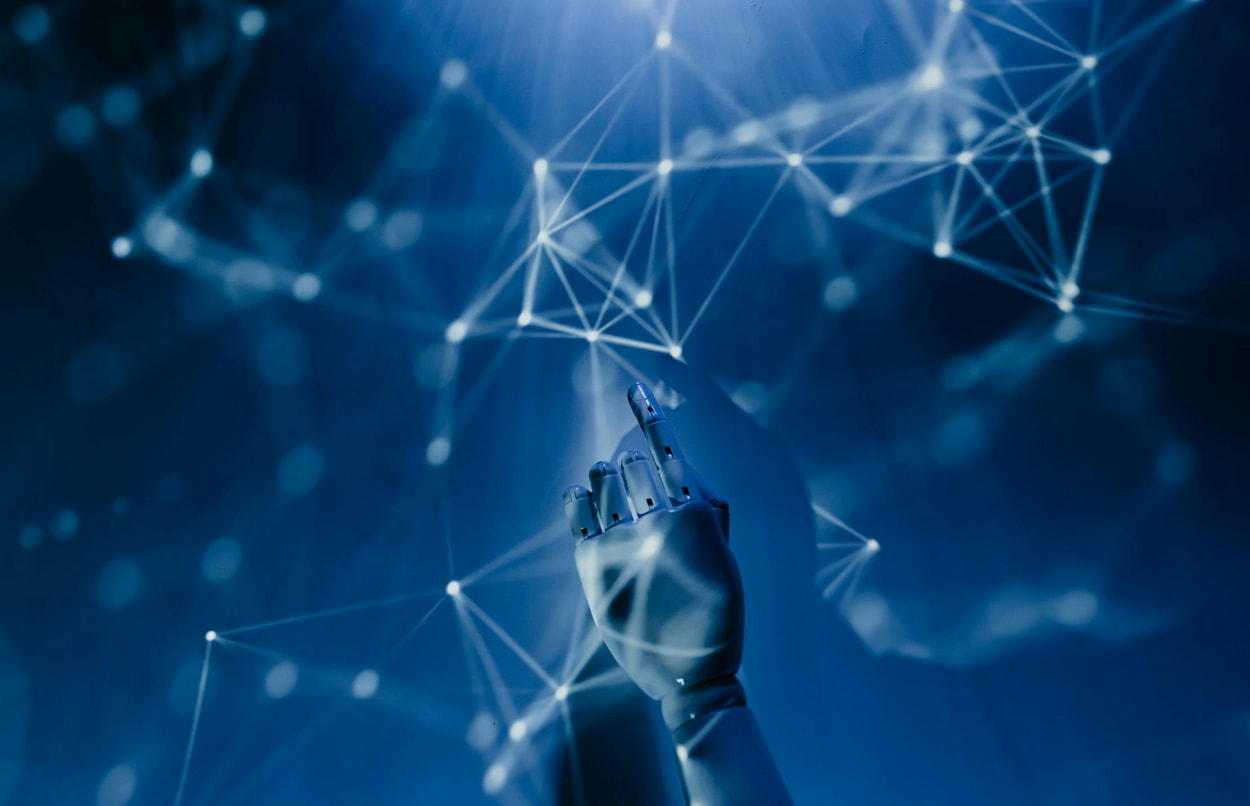The American economy has already witnessed AI adding over $400 billion as of 2024. Experts estimate this could rise to a mind-boggling $4.4 trillion by 2030.
These technologies are not merely automating mundane chores or creating new content. They are solving issues previously considered too difficult for computers to solve.
What we are seeing is a quantum leap in the way intelligent machines power innovation. That is a tremendous, sudden leap forward, not incremental steps.
Here, we will discuss how these smart machines are powering the next wave of innovation.
Optimizing Complex Financial Models
The financial world is full of massive, complex data. Making sense of it all and predicting market movements is a huge challenge.
AI and machine learning are fundamentally changing how financial institutions operate. They analyze vast datasets to improve decision-making, manage risks, and detect fraud.
For risk management, AI looks at everything from social media sentiment to economic indicators. This helps banks and investors understand credit and market risks dynamically.
BlackRock is a case in point. This major asset management company uses AI to analyze thousands of earnings call transcripts and broker reports daily.
AI also helps with credit risk. Upstart, an AI lending platform, for instance, approves more borrowers than traditional models. It does this by looking beyond typical credit scores and offering fairer assessments.
That isn’t all. AI processes huge amounts of market data to forecast returns and risks for investment analysis. It uses machine learning to identify patterns in stocks, bonds, and real estate.
AlphaSense and Kavout are examples. They offer market intelligence and AI-powered stock ranking systems.
AI uses advanced techniques to create adaptive strategies. These strategies respond to market changes, helping to optimize portfolios.
BlackRock's Aladdin platform is a great example of this. AI’s ability to analyze diverse and non-traditional data sets is expanding access to financial services. It allows for more nuanced risk assessments and personalized advice.
Fraud detection is another big win for AI. Companies like Shopify use AI algorithms to identify suspicious transactions. They analyze location, device, and past behavior to flag potential fraud.
Accelerating the Drug Discovery Process
Developing new medicines has always been incredibly slow and expensive. It is a tough, trial-and-error process with a high failure rate.
AI and machine learning are changing this dramatically. They can analyze huge amounts of data and make predictions much faster than humans. This helps researchers find new therapeutic targets and design potential medicines.
A key development is the ‘lab in a loop’ approach. This system transforms experimental and clinical data into computational models. These models predict how cells will react to different drug candidates.
The loop signifies a continuous learning process. AI-generated predictions are tested in lab experiments, and the results are then fed back into the models. This improves their accuracy and predictive power.
AI models can also predict protein structures. Twist Bioscience uses them, and the results are impressive. It has been able to improve prediction speed by 82%.
Generative AI isn’t new in drug discovery; it has been transforming it since 2017.
Companies like Insilico Medicine and AstraZeneca were early pioneers. The results are impressive. AI-designed drugs are entering clinical trials much quicker. DSP-1181, the first AI-designed drug in clinical trials, took only 12 months for its discovery phase. Traditionally, this takes 4 to 5 years.
Insilico Medicine identified new drug targets and generated candidate molecules in just 18 months. Its IPF drug, Rentosertib, was entirely AI-discovered.
Analyzing Behavior to Offer Personalized Content
AI is incredibly good at learning about your unique preferences. It looks at your browsing history, purchases, and social media interactions. This understanding allows AI to offer content and products that feel tailor-made just for you.
Netflix is a prime example of this in streaming. Research indicates that up to 80% of content watched on Netflix comes from personalized recommendations.
Social media platforms also use AI and ML to serve you personalized content.
Take Snapchat, for instance. It uses AI to track how you interact with stories, lenses, and friends, and even how long you linger on certain types of content. All of that data helps tailor what you see next. This level of personalization isn’t just convenient but addictive. The more relevant the content, the longer you stay.
The Snapchat lawsuit highlights the dangers of this addiction, especially for children.
The widespread use of Snapchat and other social media platforms by young people has been linked to numerous reports of mental health concerns. According to TorHoerman Law, children have suffered from body dysmorphia, eating disorders, anxiety, self-harm, and suicidal ideation.
In online shopping, too, AI personalizes product recommendations. Amazon's ‘Buy It Again’ feature anticipates your needs by highlighting frequently purchased products. Companies like Yves Rocher saw an 11x increase in purchase rates with AI-powered recommendations.
AI also powers chatbots for instant, personalized customer support, improving customer service and reducing response times. From welcome mail to post-purchase messages, AI delivers the correct message at the correct time. This hyper-personalization is a powerful driver of user engagement, retention, and ultimately, business growth.
Solving Logistics and Supply Chain Problems
Managing supply chains is incredibly complex. It involves predicting demand, optimizing routes, and dealing with unexpected disruptions.
AI and machine learning are making supply chains much smarter and more resilient. They help reduce costs, improve efficiency, and boost customer satisfaction. This helps companies predict things like traffic and weather. This allows them to find the best routes and schedules, saving time and fuel.
UPS's ORION system, for example, optimizes millions of routes daily. DHL uses ML algorithms to predict scenarios and optimize shipment space.
Equally important is managing inventory. Walmart uses AI and ML to optimize its stock. This prevents both overstocking and empty shelves.
This demonstrates that AI's integration into logistics and supply chains is fundamentally creating more resilient, transparent, and efficient systems. It is moving these operations from being reactive to being proactive, optimized, and highly adaptable.
AI also excels at demand forecasting. It uses historical data and market trends to predict what customers will want. This helps businesses avoid shortages or excess stock.
IBM's ‘Transparent Supply Chain’ initiative is an example. Using AI and ML, IBM reduced inventory levels by 18% and cut critical supply chain disruption management time from 18-21 days to mere hours. And during the COVID-19 pandemic, it maintained 100% order fulfillment.
AI also helps with predictive maintenance for vehicles and equipment. DHL uses noise sensors to predict when its sorters need maintenance, minimizing downtime.
The takeaway? AI is making businesses more productive and creating new products and services.
It complements human ingenuity. AI handles the complex data crunching and repetitive tasks, freeing up human experts to focus on creativity, strategy, and truly innovative work.
In short, the quantum leap in AI and machine learning isn't just about smart machines. It is about how these machines empower us to solve bigger problems, discover new possibilities, and build a more efficient, personalized, and resilient future.
Frequently Asked Questions
Q1. How are smart machines actually changing industries?
AI and ML are changing industries in more ways than most people realize. In healthcare, AI helps spot diseases earlier and accelerate the drug discovery process. In finance, it’s detecting fraud in seconds. Retailers use it to personalize shopping, and manufacturers use it to predict when machines will break down.
Q2. Will AI and ML displace human work?
Some careers will evolve, and a few will disappear. However, humans will continue to be valuable for activities that need creativity, emotional intelligence, and thinking about the big picture. The trick is remaining flexible and figuring out how to collaborate with intelligent machines, rather than fighting against them.
Q3. How does AI differ from standard software?
Traditional software has simple rules—if you instruct it to do X, it performs X. AI, however, learns from data and improves over time. AI can detect patterns, learn from new data, and optimize its own performance without being reprogrammed.
Q4. Can small businesses benefit from AI, or is it just for big tech?
AI is no longer just for large corporations. Small businesses are leveraging AI platforms to do things such as automating customer service, predicting sales, managing inventory, and creating marketing copy. There are so many easy-to-use platforms these days that make it so much easier, even if you do not have a full-time tech department.
Q5. What is the role of data in all this AI advancement?
Data is the fuel for training artificial intelligence. Without quality data, even the most sophisticated AI can't accomplish much. The more precise, varied, and well-structured your data is, the better your AI tools will perform. These systems learn, make predictions, and get better by processing huge amounts of data, enabling them to identify patterns and connections.















